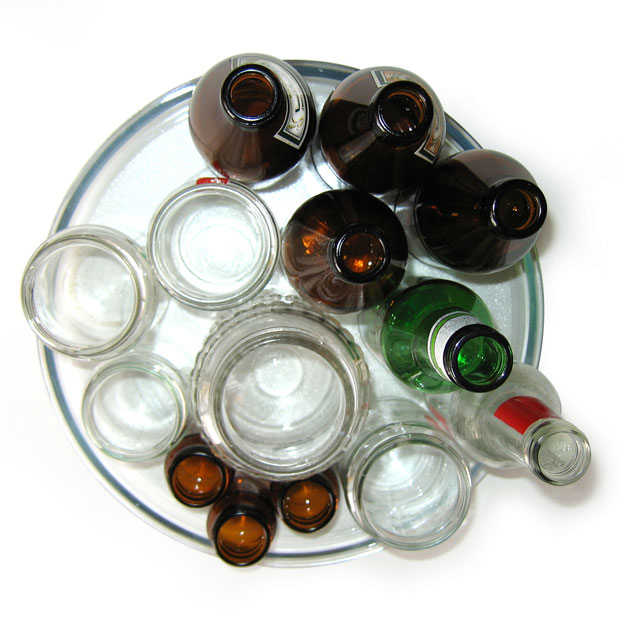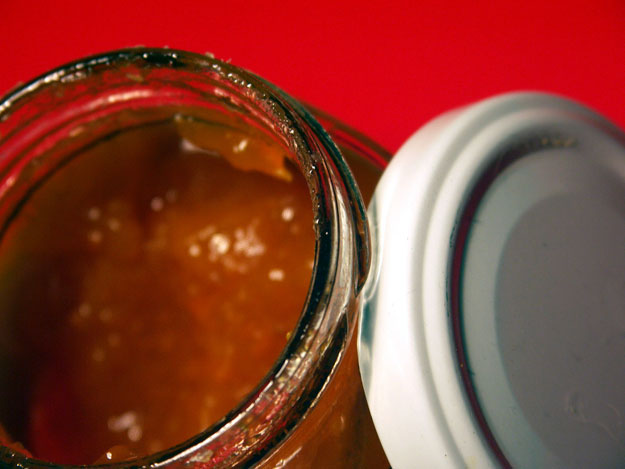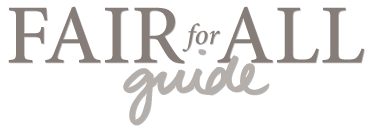
I had an idea at the grocery store recently as I was shopping for pasta sauce, salsa, and some other packaged foods. Lately I’ve been conflicted about glass jars. On the one hand, glass is infinitely recyclable with no loss of quality, while plastic can lose quality during the recycling process due to contamination from incompatible plastic polymers. On the other hand, it’s more energy efficient to recycle glass than plastic—both types of recycling save energy over producing new materials, but plastic saves significantly more. As I pondered which material was the more responsible choice for food packaging, it occurred to me that I was asking the wrong question.
Reusing an item generally has a lower environmental impact than recycling it. What if, somehow, all the containers used to sell packaged food were reusable? Not simply by the consumer, but by the food companies themselves?
The milkmen of yore reused the same glass bottles over and over again. Some modern companies like Oberweis Dairy continue to do the same—they use a deposit system to incentivize customers to return glass jugs to the store to be reused. What if all food packaging was standardized in such a way that companies could collect containers, clean them, and use them to package more food?
For this system, I’m envisioning various sizes of glass jars and bottles to be used for products that are already sold in these types of vessels. Rather than brands custom-molding their own glass or plastic containers with their logos or special shapes, they would use one of the standard containers agreed upon by the industry. There could be a wide range, maybe 15 to 20 sizes and shapes to accommodate various types of products, but all standardized in style and material.
Standardization would be necessary to facilitate the easy return and redistribution of the containers. With standard containers, collectors (primarily grocery stores) would be able to accept containers from various brands. Stores would encourage consumers to return containers by operating a deposit system. The cost to “rent” food packaging, maybe 25 to 50 cents an item, would be built into the price of packaged items, and upon returning the packaging, the consumer would receive their deposit back. (This system has the additional benefit of encouraging consumers to cook fresh food rather than pay more for packaged food, if they don’t plan to return the packaging.) A middleman company would separate the containers, remove their labels, clean and sanitize them, and redistribute them back to food manufacturers for reuse.

Imagine buying a jar of salsa. (Mmm, salsa.) When you’ve enjoyed your nachos and the jar is empty and rinsed, instead of tossing it in the recycling, you would toss it in a bag to return to the grocery store on your next shopping trip. Upon returning your empties, you would receive a refund of your packaging deposit. Retailers could even offer the refund in the form of store credit to build customer loyalty. For consumers already accustomed to recycling, this system is only a minor adjustment to a familiar habit. For consumers who don’t recycle, this system offers convenience and a financial incentive.
Such a system wouldn’t be without its costs. Food companies would have to purchase the containers back from the middlemen, or take on the costs of running their own collection program. There would be environmental impacts from transporting and cleaning the collected containers. However, in this closed loop, there would be nearly zero end-of-life packaging waste, notwithstanding containers that break or don’t make it back to collection. Glass containers are costly to transport due to their weight, but since new containers would need to be transported anyway—in addition to consuming raw materials and requiring disposal efforts, my hypothesis is that the costs and impacts of the reuse program would be significantly lower than the costs and impacts of creating and disposing of new packaging.
The biggest perceived cost to food companies of such a system may be the limitations on branding and design. Packaging designers would lose the ability to convey a brand’s identity through the materials, shape and other characteristics of a product’s container, and due to the consistent containers, grocery store shelves would become much more homogeneous. However, a designer would still be able to differentiate a brand through the color, material, shape, size, and style of its products’ labels. In fact, the new limitations could lead to a boom in creative label design—as long as the label can be removed from the container by the consumer or during the cleaning process, any treatment is fair game! Shelf homogeneity could be addressed with dividers, different styles of shelving, or point-of-sale displays.
This system could be applied to other packaged goods as well, such as household cleaners or personal care products—basically anything that’s sold in liquid form or in small pieces. I’m not sure if there would be contamination risks if reusing, say, a shampoo container for hot sauce, so there may need to be different styles of containers for non-food products.
I personally get really excited envisioning such a radically different (but honestly, not that different) future for consumer packaging. I’m already thinking of the opportunities it would create. (Jobs running collection and processing programs! A market for reusable non-slip bottle coozies!) Obviously this hypothetical system would require a major coordinated effort between manufacturers and retailers, and likely changes to food packaging regulations as well. However, I was telling my dad about the idea and he said companies like Coca-Cola used to collect bottles back when he was a kid, so it’s certainly not unprecedented. If the environmental impacts, especially carbon emissions, are significantly lower compared to new packaging production and disposal, I could see this system as a potential way forward for American food distribution.

I like this idea a lot. As for the cross-contamination thing, maybe the glass could be different colors based on what it’s used for. That way we automatically know that green is for hair care and clear is for food (or whatever).
I was thinking a color-coded system too!
“When you’ve enjoyed your nachos and the jar is empty and rinsed, instead of tossing it in the recycling, you would toss it in a bag to return to the grocery store on your next shopping trip. Upon returning your empties, you would receive a refund of your packaging deposit. Retailers could even offer the refund in the form of store credit to build customer loyalty.”
Hey! I live in Germany, and that’s exactly how plastic and glass bottles are handled; a deposit is part of the price, and after you use the product, you stick the bottle in a machine at the grocery store that scans or measures the bottle to determine how much your deposit was. The machine prints a receipt/coupon with your money-back total, which you take to checkout. I assume you can get cash back for it, but I’ve always had that amount deducted from my normal grocery total, if that makes sense.
It seems to be a great system, and I wish it applied to a zillion other products! There’s still a ton of plastic packaging around here— often, individual cucumbers are wrapped in plastic. Drives me nuts.
That’s awesome! Is it a recycling program, or do some of the returned containers actually get reused? Plastic packaging on produce is a huge pet peeve of mine too!
Came to post the same comment about Germany! I know for sure that the beer bottles are re-used because you can see all of the scuffs on the older bottles! The “pfand” on aluminum cans and plastic bottles is 0.25EUR though, so there is some pretty heavy incentive to return it for recycling. There is also the added benefit of reducing littering. Littering went way down after implementation since people could go around collecting “trash” and make serious money off of it. You see tons of people at night digging in garbage cans looking for some quick cash.
I also love this idea. I feel like companies would have to be mandated to do so – and I don’t even know which entity even remotely has that power.
Hello Maam,
I live in Bangalore, India. I too wish to do something to reuse the dettol, vim, hair care bottles and many other plastic items. I think of a system which could get on collecting these things from homes, bifurcate them, clean and then give it back to companies for reuse. It bothers me that am doing nothing even though I see so much of plastic around me that is harming mother nature. I need help to take up this task. I felt I could share this with you.
Thanks for sharing your vision! You’re right, plastic is another big problem. Applying this kind of collection and reuse program to plastic would require knowledge of the different types of plastic and how durable they are. I could see some plastics holding up well enough to be reused.
I had the same vision for reusable food packaging. It is certainly the future although distant, probably. Perhaps in 100 or 200 years something like this will be implemented when our descendants are wading through oceans of garbage from the current unsustainable packaging methods. It would be possible and likely more sustainable to have standardized plastic packaging since it is lighter and less fragile. Automated computer vision inspection systems could scan the washed containers for excessive surface wear or breakage, and reject worn containers for recycling. The only way to implement this system would be through federal regulation, unless some company can invest so heavily in this future that corporations would start to look bad if they didn’t adopt it (I’m looking at you, Waste Management). The reusable packaging system would be integrated into existing recycling services with home pickup.
I have been brainstorming a similar idea lately and think that is where things need to go, but it won’t be easy. The dream would be that homes and businesses would start having a reuse bin in addition to or instead of trash, recycling, and compost. If the materials for re-use could be labeled properly and then there was an established cleaning and sanitation system that could be used by either the company handling the reuse containers or the end users (food companies, restaurants, or grocery stores). Anyone know of good materials that reusable containers could be made out of. Glass is good, but may be too heavy so shipping costs would go up. Maybe the Amazon acquisition of Whole Foods will be a first step to enable this type of ecosystem?
That’s an interesting thought about the Amazon/Whole Foods acquisition. If anyone has the logistical strength to pull off a pilot like this, it would be Amazon. I agree that the weight (and breakability) of glass isn’t ideal. Maybe there’s a future in lightweight, durable carbon-fiber packaging!
When we started planing our new food delivery and take away service (DeliKaktus) in Germany last year, the same waste problem was in mind. We ran a 3 weeks experiment with our top glass choices (based on local availability and design criteria), and let our costumers to rate them in a simple yet elaborated survey. We then used these results to narrow down our choices to our currently used package, which is way too heavy and expensive, but that’s what the people want to buy.
If you want to create a sustainable consumer product packaging system, you must comply (at least at the initial phase) with the regulated capitalist system. That means that food safety, free choice and profitability are the basis, and on that you start building a sustainable scheme. I would start in creating a small scale model which is sound by itself, and then the giants will already invest the billions needed to keep controlling this fast changing market.